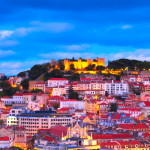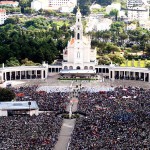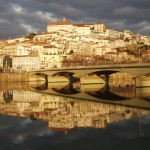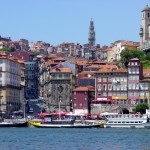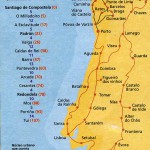September 19-29, 2015. Travel to Portugal and Spain
In the travel’s program:
-
Tour of Lisbon, Portugal’s capital. Lisbon is the westernmost capital of Europe. The European continent ends off at Cabo da Roca (Cape Roca) not far from the city, and beyond this point there is only the boundless Atlantic Ocean. There are not so many historic sites of interest in Lisbon, because in 1755 the city was almost completely destroyed by an earthquake, and tsunamis and fires following it, but very soon it sprang from the ruins according to the project of 1st Marquis of Pombal. Still, on every corner in Lisbon you can see the reminders of the imperial past of the city: magnificent cathedrals, elegant palaces, and pompous monuments to kings and marquises.
- Trip to Cape Roca. Cape Roca is the westernmost tip of the continental Europe. Portuguese poet Luís de Camões describes this place in the following way, “It is the place, where the land ends and the sea begins.” We will try to get here in the evening to see the most beautiful sunset.
- Tour to the city of Sintra. The city lies on the northern slopes of the wooded hills of Serra De Sintra mountain range, thirty kilometers north-west of Lisbon and only twelve kilometers from the sea shore. In the past, Sintra served as a summer residence for the royal family, and now it remains a Romantic tourist center. Among the thick woods on the slopes of the hills, ancient palaces and manors are hidden, from which there are beautiful scenic views.
- Trip to the town of Fátima. Fátima is one of the most revered sites of pilgrimage in the Catholic World that can be compared in its significance to French Lourdes and Spanish Santiago de Compostela. On May 13, 1917, three little shepherds told of the apparition of the Virgin Mary to them. Our Lady made three prophesies to the children, and in October an unusual celestial scene had occurred, witnessed by thousands of believers. Two children soon after that died of influenza, and the third one – Lucia, became a Carmelite nun and died at the convent of Coimbra in 2005.
-
Visiting the city of Coimbra. Coimbra was the Portugal’s capital in the 12th—13th centuries with the oldest university in the country, the Baroque library, and numerous churches and monuments, including a former Archbishop’s Palace. Six kings of Portugal were born in Coimbra, which for more than a century was the country’s capital. It is the home of the oldest university, founded by King Dinis in 1290, and until 1910 it was the only university in Portugal. Sé Velha Cathedral is one of the best specimens of the Romanesque architecture in Portugal. In 1503, the interior of the church was decorated with tilework panels. From that time, azulejo tiles became widely used in the décor of Portuguese temples. In the western gallery, wooden ceilings in the Moorish style have remained since 1520. Sé Velha Cathedral was built at the turn of the XVIth century by Jesuits, and later it was rebuilt in the early Baroque style.
- Tour to the city of Aveiro. The city of Aveiro is first mentioned in 959 under a Latin name Aviarium. In 1515, Aveiro received the city rights. In the XVIth—XVIIIth centuries, the city belonged to the Dukes of Aveiro – - descendants of Infante George. Sometimes the city is called Portuguese Venetia, because of the river that runs through the city and local boats that have a characteristic shape and colouring. One of the attractions of Aveiro is a Jesuit Monastery of the XVth century, in which King Alfonso V’s daughter, St. Joana is buried, who died in 1490 and was canonised in 1673.
-
Tour to the city of Porto. Porto, Portus Cale – is the second largest city in Portugal, behind Lisbon. There was a settlement in the area of the modern Porto long before the Romans had arrived here. The Romans called the city Portus Cale. Later, this name was transformed into Portucale. Derived from it, came forth the County Condado Portucalense, which later gave the name to the whole country — Portugal. In the historic centre of the city there is the Cathedral of the XIIIth century Sé do Porto, a majestic monument of the Romanesque architecture in Portugal. One of the most outstanding sites of interest in Porto is the Clérigos Tower — the tallest tower in Portugal, 78 meters tall. The construction of the tower was carried out from 1754 until 1763.
- Pilgrimage to Santiago de Compostela via the Portuguese route of Camino. Camino Portugues, or the Portuguese Way, is one of the oldest routes in Europe that traditionally starts from one of the two Portuguese cities – Lisbon or Porto, following along the Atlantic coast. Camino Portugues goes through many historic monuments — religious holy sites, temples, altars, wayside crucifixes, chapels, and monasteries and convents. Besides that, another good thing about this charming way is its soothing solitude. Among the travellers, the Portuguese Way is also otherwise known as the Friendly Camino. And this reputation is absolutely due. The dwellers of the cities along the Way are faithfully keeping the legends and helping the voyagers on this ancient route. In every village and every city of the Camino Portugues there are a few bars and restaurants where one can enjoy the national dishes and worldwide known Portuguese and Spanish wines that have been produced according to the old recipes for over a thousand years.
The Portuguese Way is running mainly through a flat area, with an exception of several small hills. Therefore, together with the French way, it is considered to be less difficult for a journey on foot.
In the follow up of the journey, I will prepare and publish my report and photographs.

